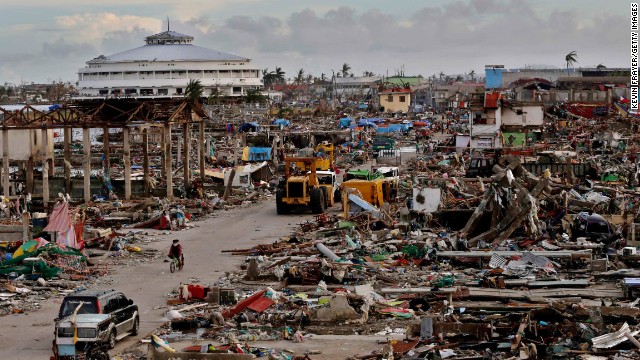
In the grieving, grey wastelands that were once bustling towns on tropical Philippine islands, thousands of typhoon survivors are enduring an agonising wait of hope and denial for news of loved ones.
Nearly 1,800 people are officially listed as missing after Super Typhoon Haiyan swept across the central Philippines just over a month ago, and not knowing what happened to them is for some relatives nearly as painful as confirmation that they died.
Francis Batula, 35, buried his aunt and four other relatives in shallow graves outside their badly damaged home in the coastal city of Tacloban, where giant storm surges wiped out thousands of homes as well as schools, churches and other places serving as evacuation centres.
His aunt was in her house facing the Pacific Ocean, along with her husband and daughter. The aunt?s body was found but not those of the other two, and Batula refuses to acknowledge that his uncle and cousin are likely dead.
We are still hoping that they are safe, but that they can't contact us. Maybe there's no (phone) signal where they are now, Batula told AFP after walking past the graves of his five other relatives.
Batula said he and other relatives had paid fruitless visits to neighbouring communities to ask if people had seen his uncle and cousin, and expressed anger at authorities for not doing enough to search for the missing.
?All they are doing is asking for the names of the missing people. They say they will report it. But when you ask them what they will do to help you find them, there is no concrete answer? they say it's not a priority right now, he said.
The government insists it is doing all it can to find the missing but, like virtually all other aspects of the disaster, the magnitude of the response needed is overwhelming.
The number of people confirmed killed is 5,936, and just the task of dealing with the dead has been too much to handle properly, with countless bodies having been dumped into mass graves without being properly identified.
The typhoon on November 8 generated tsunami-like storm surges that powered through dozens of coastal communities on the islands of Leyte and Samar, and piles of rubble from destroyed homes still lie in the streets.
As that debris is being cleared by cash-for-work clean-up crews of survivors and just a few bulldozers, bodies continue to be found.
Amid the chaos, there are haunting messages for the lost.
Churchgoers browse lists of missing people and look at posters appealing for help that are pinned up to the entrances of cathedrals.
At the Santo Nino church in Tacloban, a photocopied photo of a three-year-old boy hangs on a notice board.
Alongside, a handwritten message says the boy was wearing an orange life vest and diapers, but no shirt, when he went missing on November 8. The phone numbers of five people are listed for anyone with information to call.
The Red Cross is playing an important role in trying to find the missing.
It sends tracing teams into communities to look for people after they are reported by relatives or friends as having disappeared.
One of the charity organisation?s team leaders in Tacloban, Iris Recto, said her small team had found at least eight people a day over three weeks, with a record daily success of 29, by searching in evacuation centres and communities.
But Recto said the Red Cross cases mainly involved relatives overseas or elsewhere in the Philippines reporting missing people.
The Red Cross typically finds people who had lost their phones or were living in an area without a phone signal, so had been unable to call relatives outside the disaster areas, according to Recto.
For the 1,779 people listed by the government as missing, they have been reported by relatives and local officials in the communities where they lived.
And the fate of many people swept out to sea or buried anonymously in mass graves will likely never be known.
National Disaster Risk Reduction and Management Council spokesman Reynaldo Balido told AFP that it would not declare any of the missing as dead until local officials officially made that pronouncement.
This sometimes happened one year after the disaster, even without an official identification of the body.
But Balido acknowledged that in the history of tracking the frequent typhoons, earthquakes and other disasters that plague the Philippines, the figures often permanently end up as "dead and missing"
He cited the case of Typhoon Bopha, the world?s deadliest storm last year, which tore across the southern Philippines on December 4, and officially killed 902 people.
But more than a year later, relatives of 934 people still listed as missing continue to live in a tortuous limbo.
Tuesday 10 December 2013
http://www.google.com/hostednews/afp/article/ALeqM5h_M6KzVzrM0TJeFXXbAKEuDXTmEg?docId=62154848-3ced-4bb5-b9c4-8b5df26e3c27



